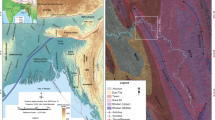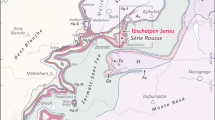Abstract
More than 50% of the Alps expose fragments of Palaeozoic basement which were assembled during the Alpine orogeny. Although the tectonic and metamorphic history of the basement units can be compared to that of the Variscan crust in the Alpine foreland, most of the basement pieces of the Alps do not represent the direct southern continuation of Variscan structural elements evident in the Massif Central, the Vosges–Black Forest or the Bohemian massif. The basement units of the Alps all originated at the Gondwana margin. They were derived from a Precambrian volcanic arc suture fringing the northern margin of Gondwana, from which they were rifted during the Cambrian–Ordovician and Silurian. A short-lived Ordovician orogenic event interrupted the general rifting tendency at the Gondwana active margin. After the Ordovician, the different blocks drifted from the Gondwana margin to their Pangea position, colliding either parallel to Armorica with Laurussia or with originally peri-Gondwanan blocks assembled presently in Armorica. From the Devonian onwards, many basement subunits underwent the complex evolution of apparently oblique collision and nappe stacking. Docking started in the External massifs, the Penninic and Lower and middle Austroalpine units in approximately Devonian/early Carboniferous times, followed by the Upper Austroalpine and the South Alpine domains, in the Visean and the Namurian times, respectively. Wrenching is probably the best mechanism to explain all syn and post-collisional phenomena since the Visean followed by post-orogenic collapse and extension. It explains the occurrence of strike-slip faults at different crustal levels, the formation of sedimentary troughs as well as the extrusion and intrusion of crustal and mantle-derived magmas, and allows for contemporaneous rapid uplift of lower crustal levels and their erosion. From the Stephanian onwards, all regions were deeply eroded by large river systems.
Similar content being viewed by others
Author information
Authors and Affiliations
Additional information
Received: 23 December 1997/ Accepted: 5 July 1998
Rights and permissions
About this article
Cite this article
von Raumer, J. The Palaeozoic evolution in the Alps: from Gondwana to Pangea. Geol Rundsch 87, 407–435 (1998). https://doi.org/10.1007/s005310050219
Issue Date:
DOI: https://doi.org/10.1007/s005310050219




